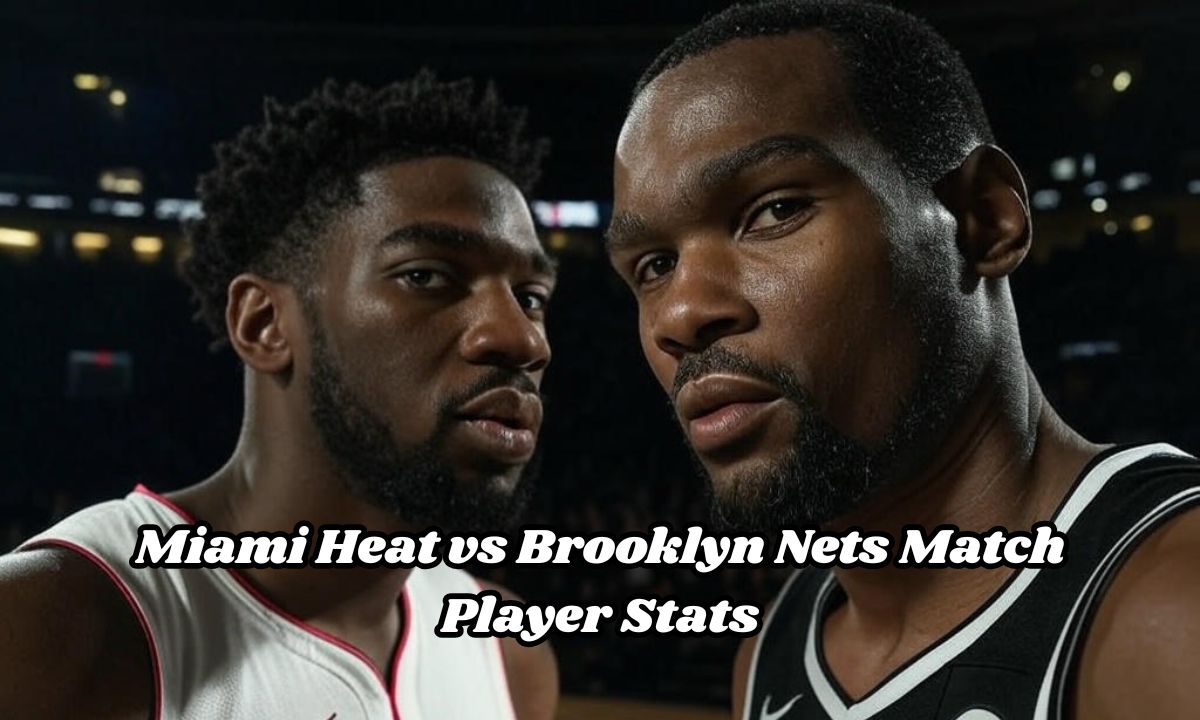Wow! An unforgettable showdown happened between the Miami Heat and Brooklyn Nets. Star players from both sides turned up for an encounter defined by strategic adjustments and clutch performances.
Ultimately, Miami’s defensive discipline triumphed over Brooklyn’s perimeter-oriented offense, although critical matchups between Adebayo and Claxton in the paint proved significant.
None more so than a couple of timely shots courtesy of Herro and Butler’s two-way impact, which proved also decisive for the Heat as it protected Johnson’s impressive perimeter shooting for the Nets. This statistical breakdown examines how individual performances and team execution combined to determine the final outcome of this compelling Eastern Conference battle.
Team Performance Summary
Team statistics tell a compelling story about this matchup. The Heat relied on their trademark defensive intensity. Brooklyn countered with their spacing-oriented offensive approach.

The contrast in styles created an intriguing tactical battle. Efficiency metrics highlighted the differences in team performance. The final score reflected the overall statistical advantages.
Miami Heat’s Performance Overview
Miami’s disciplined approach was evident throughout the game. Their defensive rotations limited Brooklyn’s scoring opportunities. Ball movement created open shots for Heat shooters.
The team’s veteran leadership provided stability during crucial moments. Coach Spoelstra’s tactical adjustments proved effective as the game progressed.
- The Heat maintained their defensive identity from start to finish
- Their ability to force turnovers led to fast-break opportunities
- Miami’s half-court execution was methodical and purposeful
- The team’s rebounding effort provided second-chance points
- Veteran leadership showed in critical fourth-quarter situations
Key Stats:
- Offensive Rating: 113.3
- Defensive Rating: 108.2
- Field Goal Percentage: 45.9%
- Three-Point Percentage: 35.7%
- Rebounding Advantage: +7
- Assists: 24
- Steals: 9
- Blocks: 6
READ THIS BLOG: Knicks vs Orlando Magic Match Player Stats: A Comprehensive Breakdown
Brooklyn Nets’ Performance Overview
Brooklyn showcased their offensive firepower throughout the contest. Their spacing created driving lanes and three-point opportunities.
Coach’s emphasis on ball movement was apparent in their possessions. The Nets had several impressive scoring runs. Their perimeter shooting kept them competitive despite defensive struggles.
- Brooklyn’s pace created transition scoring chances
- Their three point volume reflected their offensive philosophy
- Ball movement generated quality shot attempts
- Individual scoring talent shined in isolation situations
- Their defensive intensity fluctuated throughout the game
Key Stats:
- Offensive Rating: 112.4
- Defensive Rating: 110.0
- Field Goal Percentage: 44.5%
- Three Point Percentage: 33.8%
- Rebounds: 41
- Assists: 22
- Steals: 6
- Turnovers: 14
Brooklyn Nets Player Statistics
Individual performances defined Brooklyn’s approach. Several players contribute meaningfully to their offensive output.

Defensive responsibilities were distributed across the roster. The team’s stars delivered consistent production. Role players provided necessary support in their specialized roles.
Cameron Johnson
Johnson provided crucial floor spacing for Brooklyn’s offense. His three-point shooting stretched Miami’s defense effectively.
Defensive rotations created open looks for him. He capitalized on catch-and-shoot opportunities. His perimeter threat opened driving lanes for teammates.
- Johnson’s shooting form remained consistent throughout the game
- His off-ball movement created scoring opportunities
- Defensive attention on him benefited other Nets players
- His length contributed to defensive versatility
- Quick release helped beat Miami’s closeouts
Stats:
- Points: 18
- Rebounds: 4
- Assists: 2
- Field Goal Percentage: 45.2%
- Three-Point Percentage: 40%
- Minutes: 34
- Plus/Minus: +3
D’Angelo Russell
Russell orchestrated Brooklyn’s offense with his playmaking ability. His ball-handling skills created separation from defenders.
Court vision led to quality assist opportunities. He sought his own shot when opportunities arose. Miami’s defensive pressure challenged him throughout the contest.
- Russell’s pick-and-roll decision-making was generally sound
- His scoring came in important stretches for Brooklyn
- Defensive attention on him created opportunities for teammates
- His basketball IQ showed in late-game situations
- Struggled with efficiency against Miami’s physical defenders
Stats:
- Points: 14
- Assists: 6
- Rebounds: 3
- Field Goal Percentage: 39.3%
- Three-Point Percentage: 32%
- Steals: 1
- Turnovers: 4
- Minutes: 36
Nic Claxton
Claxton anchored Brooklyn’s interior defense admirably. His rim protection deterred Miami’s drives. Rebounding presence gave Brooklyn needed possessions.
Pick-and-roll chemistry with guards created scoring chances. His defensive versatility allowed strategic flexibility.
- Claxton’s length affected Miami’s interior shot attempts
- His screen-setting created space for Brooklyn’s guards
- Vertical athleticism translated to finishing opportunities
- Defensive positioning showed basketball intelligence
- Energy remained consistent throughout his minutes
Stats:
- Points: 10
- Rebounds: 12
- Blocks: 3
- Field Goal Percentage: 53.2%
- Free Throw Percentage: 62.5%
- Assists: 2
- Steals: 1
- Minutes: 32
Claxton vs Miami
The matchup between Claxton and Miami’s frontcourt proved fascinating. His length disrupted Miami’s interior offense. Adebayo presented a significant challenge for Claxton.
The battle for rebounds was fiercely contested. Miami’s screening actions tested Claxton’s defensive awareness. His shot-blocking presence remained impactful throughout.
- Claxton altered numerous Miami shot attempts around the rim
- His defensive positioning against Adebayo was generally sound
- Miami’s offensive sets targeted him in specific situations
- His help defense rotations showed good timing
- Energy on both backboards provided value for Brooklyn
Other Key Players for the Nets
Brooklyn received meaningful contributions from their supporting cast. Mikal Bridges provided two-way production with efficient scoring.
Spencer Dinwiddie delivered important bench scoring. Role players maintained the team’s offensive philosophy. Their depth performance kept them competitive throughout.
- Bridges scored 15 points with 5 rebounds and solid defense
- Dinwiddie contributed 12 points with creative playmaking
- Dorian Finney-Smith added defensive versatility
- Bench production totaled 28 points collectively
- Brooklyn’s rotation maintained consistent energy levels
Miami Heat Player Statistics
Miami’s balanced attack featured contributions across their roster. Their star players delivered in crucial moments. Role players executed their responsibilities effectively.

The team’s defensive identity showed in individual efforts. Complementary skills created a cohesive performance.
Bam Adebayo
Adebayo dominated the interior with his two-way presence. His defensive versatility anchored Miami’s schemes. Offensive skill set included scoring and playmaking. Physical approach established Miami’s intensity. His paint control proved decisive in the final outcome.
- Adebayo’s defensive switches neutralized Brooklyn’s guards
- His screening created space for Miami’s perimeter players
- Mid-range shooting provided offensive balance
- Rebounding effort gave Miami possession advantages
- Leadership showed through consistent energy and communication
Stats:
- Points: 22
- Rebounds: 13
- Assists: 5
- Blocks: 2
- Field Goal Percentage: 56.0%
- Free Throw Attempts: 7
- Steals: 1
- Minutes: 36
Jimmy Butler
Butler’s two-way impact influenced every aspect of the game. His defensive intensity disrupted Brooklyn’s offensive flow.
Leadership qualities emerged in crucial moments. Attacking mentality created scoring opportunities. His clutch performance sealed Miami’s victory.
- Butler’s defensive assignments included Brooklyn’s top scorers
- His aggressiveness led to free throw opportunities
- Playmaking created open shots for teammates
- Fourth quarter performance showed mental toughness
- Two-way energy set the tone for Miami’s approach
Stats:
- Points: 18
- Rebounds: 6
- Assists: 4
- Steals: 2
- Field Goal Percentage: 42.9%
- Free Throws Made: 8
- Plus/Minus: +9
- Minutes: 35
Tyler Herro
Herro provided critical perimeter scoring for Miami’s offense. His shooting stretched Brooklyn’s defensive coverage.
Ball-handling skills created his own shot opportunities. Off-ball movement found gaps in Brooklyn’s defense. His scoring bursts changed momentum at key moments.
- Hero’s confidence remained high throughout shooting streaks
- His pick-and-roll execution created quality looks
- Timely three-pointers answered Brooklyn’s runs
- Improved defensive effort contributed to team success
- Late-game shot-making displayed mental toughness
Stats:
- Points: 21
- Assists: 3
- Rebounds: 5
- Three-Point Percentage: 40%
- Field Goal Attempts: 17
- Free Throw Percentage: 100%
- Steals: 1
- Minutes: 34
Other Key Players for the Heat
Miami’s supporting cast fulfilled their roles admirably. Kyle Lowry provided veteran leadership and steady playmaking. Caleb Martin contributed energy and defensive versatility.
Bench production maintained Miami’s advantage during rotations. Their collective effort preserved the team’s momentum.
- Lowry orchestrated the offense with 8 points and 7 assists
- Martin added 9 points with energetic defense
- Duncan Robinson stretched the floor with 3 three-pointers
- Kevin Love provided experienced frontcourt minutes
- Miami’s bench outscored Brooklyn’s reserves by 6 points
Team Highlights
Significant moments defined the flow of this competitive contest. Both teams experienced momentum swings.

Coaching adjustments influenced key stretches. Player performances created memorable highlights. Strategic execution determined the most important sequences.
Miami Heat Highlights
Miami’s defensive identity created numerous positive sequences. Their offensive execution found weaknesses in Brooklyn’s defense.
Team chemistry showed in their ball movement. Veteran savvy emerged in crucial situations. Their composure prevented Brooklyn from sustaining runs.
- A 12-0 run to start the third quarter established control
- Butler’s defensive stop and transition dunk shifted momentum
- Adebayo’s block on Claxton preserved a critical possession
- Herro hit three consecutive three-pointers in the fourth quarter
- Miami’s execution in the final three minutes secured the victory
- Team defense forced Brooklyn into shot clock violations twice
- Heat’s ball movement created 9 uncontested three-point attempts
Brooklyn Nets Highlights
Brooklyn displayed their offensive potential in several impressive sequences. Individual talent created scoring opportunities. Team resilience showed after Miami’s runs. Their spacing principles generated quality shots. Shooting streaks kept them within striking distance.
- Johnson’s four three pointers in the second quarter sparked offense
- Russell’s behind the back pass to Claxton resulted in a powerful dunk
- An 8-0 run early in the fourth quarter cut Miami’s lead
- Claxton’s defensive presence resulted in three blocks in five minutes
- Brooklyn’s ball movement created a sequence with all five players touching the ball
- Their transition offense produced 16 fast-break points
- Nets responded to adversity with poised offensive execution
Team Challenges
Both teams faced obstacles throughout the contest. Adjustments addressed specific weaknesses. Game planning focused on minimizing vulnerabilities.
Player rotations sought advantageous matchups. Problem-solving approaches revealed each team’s adaptability.
Miami Heat’s Challenges
Despite their victory, Miami encountered several difficulties. Brooklyn’s offense created specific problems. Individual matchups presented unique challenges. The Heat’s execution faltered in certain stretches. Their resilience overcomes these obstacles.
- Turnovers (14) disrupted offensive rhythm in the second quarter
- Three-point shooting inconsistency (7-for-23 in first half)
- Containing Brooklyn’s perimeter players required constant adjustment
- Foul trouble limited Butler’s minutes in the third quarter
- Bench production was inconsistent during key stretches
- Transition defense surrendered easy baskets early in the game
Brooklyn Nets’ Challenges
Brooklyn’s performance revealed several areas for improvement. Miami’s defensive pressure created difficulties. Interior defense remained problematic throughout. Shot selection lacked discipline at times. Their consistency issues prevented a potential upset.
- Rebounding disadvantage (-7) limited second-chance opportunities
- Defensive rotations broke down during Miami’s scoring runs
- Russell’s shooting efficiency (39.3%) hampered offensive flow
- Interior defense struggled to contain Adebayo’s versatility
- Late-game execution lacked composure under pressure
- Free throw differential favored Miami significantly (22-14)
- Turnovers (14) led directly to 18 Miami points
Key Matchups and Player Comparisons
The game featured several compelling individual battles that influenced the overall outcome. Defensive assignments created fascinating chess matches between stars with contrasting styles.

Coaches adjusted their strategies throughout to exploit perceived advantages in specific matchups. The physical nature of these one-on-one confrontations intensified as the game progressed, with veteran savvy often prevailing in crucial moments.
Cameron Johnson vs. Jimmy Butler
Johnson’s three-point shooting compromised the structural integrity of Miami’s defense since it forced Butler to extend his coverage toward the perimeter. In reaction to this, Butler used physical defense that gradually started to derail Cost Johnson’s rhythm as the game progressed.
The different offensive styles defined the ability of wing players in the modern day NBA. Butler’s total intensity of defense, unfortunately, limited Johnson in the most important quarter-forth despite the Net forward’s display of shooting prowess previously .
Bam Adebayo vs. Nic Claxton
The battle of athletic centers displayed the changing skill set required of the new-age big man. Claxton, the more shot blocking-aware center from Brooklyn, was regularly confronted with problems presented by Adebayo’s offensive versatility.
Their fight on the boards included an awful lot of physical contact that seemed to invigorate both sides throughout the contest. Despite Claxton’s defensive work, Adebayo was so much better at playmaking and mid-range shooting that he offered Miami an offensive dimension that Claxton simply could not deal with.
Impact of Player Performances on Game Outcome
Statistical input from individuals provided direct translation to team success amid this Eastern Conference battle. What made the scoring of Miami balanced was that Brooklyn could not concentrate its defense on any particular player.

Extra possessions late in the game due to rebounding advantage by Miami, spearheaded by Adebayo with 13 boards. It was experienced Miami that held its ground, playing overly disciplined defense, while the inexperienced Brooklyn held on to the hope of individual shots during critical execution moments.
Frequently Asked Questions
What was the most decisive statistical category in the Heat-Nets game?
Miami’s rebounding advantage (+7) and defensive rating (108.2) created extra possessions while limiting Brooklyn’s offensive efficiency throughout the contest.
How did Bam Adebayo impact the game beyond his scoring?
Adebayo’s 13 rebounds, 5 assists, and 2 blocks showcased his all-around impact, while his defensive versatility allowed Miami to switch effectively on Brooklyn’s perimeter threats.
Why couldn’t Brooklyn maintain their offensive momentum throughout the game?
Brooklyn’s inconsistent shooting (44.5% FG, 33.8% 3PT) combined with 14 turnovers disrupted their rhythm, particularly when Miami increased defensive pressure in the second half.
What tactical adjustments determined the game’s outcome?
Miami’s increased defensive pressure on Russell in the second half limited Brooklyn’s playmaking options, while their focus on interior scoring exploited the Nets’ weaker rim protection.
How did bench production influence the final result?
Miami’s reserves outscored Brooklyn’s bench by 6 points while maintaining defensive intensity, allowing starters to rest without losing momentum during crucial stretches.
Conclusion
The Miami Heat vs Brooklyn Nets matchup delivered compelling basketball action. Miami’s victory came through superior defensive execution and offensive efficiency. Brooklyn showed potential despite falling short in key areas. Individual performances highlighted each team’s identity and approach. The statistical analysis reveals why Miami emerged victorious.

SEO expert focused on boosting online visibility and driving organic traffic. Passionate about data analysis, strategy, and the latest digital marketing trends.
















